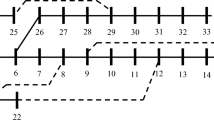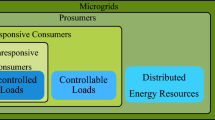Abstract
Power grid vulnerability is a critical issue in power industry. In order to understand and mitigate power grid vulnerability under threats, existing research often makes use of defender–attacker–defender (DAD) models to derive effective protection plans and evaluate grid performances under various contingencies. Corrective topology control (also known as corrective line switching) can be used as an operation to mitigate outages or attacks. In this paper, we propose to extend the traditional defender–attacker–defender model with the post-contingency corrective line switching operations as an effective post-contingency mitigation method. The proposed new model cannot be solved by existing algorithms used to solve the traditional defender–attacker–defender models because of the introduced binary transmission switching variables in the inner level problem. To solve this complicated DAD with transmission line switching (DAD-TLS) model, we customized and developed an exact algorithm based on the nested column-and-constraint generation (NCCG) algorithm, to compute global optimal solutions. A set of numerical studies on IEEE RTS one-area system demonstrate the significant improvements of power system resilience under malicious attacks due to line switching, and highlight that hardening plans derived from this new DAD model are much more cost-effective compared with those obtained from traditional DAD models.







Similar content being viewed by others
References
National Research Council: Terrorism and the Electric Power Delivery System. The National Academies Press, Washington (2012)
Economic benefits of increasing electric grid resilience to weather outages. Technical report, Executive office of the President, White House, Washington (2013)
Committee on Science and Technology for Countering Terrorism, National Research Council. Making the Nation Safer: the role of science and technology in countering terrorism. The National Academies Press, Washington (2002)
Frodl, M.G., Manoyan, J.M.: Energy security starts with hardening power grids. Natl. Defense Mag (2012). https://www.nationaldefensemagazine.org/articles/2012/11/1/2012november-energy-security-starts-with-hardening-power-grids
Salmeron, J., Wood, K., Baldick, R.: Analysis of electric grid security under terrorist threat. Power Syst. IEEE Trans. 19(2), 905–912 (2004)
Salmeron, J., Wood, K., Baldick, R.: Worst-case interdiction analysis of large-scale electric power grids. Power Syst. IEEE Trans. 24(1), 96–104 (2009)
Motto, A.L., Arroyo, J.M., Galiana, F.D.: A mixed-integer lp procedure for the analysis of electric grid security under disruptive threat. Power Syst. IEEE Trans. 20(3), 1357–1365 (2005)
Zhao, L., Zeng, B.: Vulnerability analysis of power grids with line switching. Power Syst. IEEE Trans. 28(3), 2727–2736 (2013)
Brown, G., Carlyle, M., Salmeron, J., Wood, K.: Analyzing the vulnerability of critical infrastructure to attack and planning defenses. In: Tutorials in Operations Research, INFORMS, pp. 102–123(2005)
Yao, Y., Edmunds, T., Papageorgiou, D., Alvarez, R.: Trilevel optimization in power network defense. Syst. Man Cybern. Part C Appl. Rev. IEEE Trans. 37(4), 712–718 (2007)
Bier, V.M., Gratz, E.R., Haphuriwat, N.J., Magua, W., Wierzbicki, K.R.: Methodology for identifying near-optimal interdiction strategies for a power transmission system. Reliab. Eng. Syst. Saf. 92(9), 1155–1161 (2007)
Yuan, W., Zhao, L., Zeng, B.: Optimal power grid protection through a defender-attacker-defender model. Reliab. Eng. Syst. Saf. 121, 83–89 (2014)
Alguacil, N., Delgadillo, A., Arroyo, J.M.: A trilevel programming approach for electric grid defense planning. Comput. Oper. Res. 41, 282–290 (2014)
Tas, S., Bier, V.M.: Addressing vulnerability to cascading failure against intelligent adversaries in power networks. Energy Syst. 7(2), 193–213 (2016)
Yuan, W.: Reliable power system planning and operations through robust optimization. PhD thesis, University of South Florida, Florida (2015)
Brown, G., Carlyle, M., Salmeron, J., Wood, K.: Defending critical infrastructure. Interfaces 36(6), 530–544 (2006)
Yuan, W., Zeng, B., Litvinov, E., Zheng, T., Zhao, J.: Fast computing method for two-stage robust network constrained unit commitment problem. In: Power and Energy Society General Meeting, 2015 IEEE, pp. 1–5 (2015)
Yuan, W., Wang, J., Qiu, F., Chen, C., Kang, C., Zeng, B.: Robust optimization-based resilient distribution network planning against natural disasters. IEEE Trans. Smart Grid 7(6), 2817–2826 (2016)
Zare, M., Abbaspour, A., Fotuhi-Firuzabad, M., Moeini-Aghtaie, M.: Increasing the resilience of distribution systems against hurricane by optimal switch placement. In: 2017 Conference on Electrical Power Distribution Networks Conference (EPDC), pp. 7–11 (2017)
Ruiz Duarte, J.L., Fan, N.: Operations of a microgrid with renewable energy integration and line switching. Energy Syst. 10(2), 247–272 (2019). https://doi.org/10.1007/s12667-018-0286-8
Schumacher, K.M., Chen, R.L.-Y., Cohn, A.E.M.: Transmission expansion with smart switching under demand uncertainty and line failures. Energy Syst. 8(3), 549–580 (2017)
Glavitsch, H.: Switching as means of control in the power system. Int. J. Electr. Power Energy Syst. 7(2), 92–100 (1985). https://doi.org/10.1016/0142-0615(85)90014-6
Shao, W., Vittal, V.: Corrective switching algorithm for relieving overloads and voltage violations. Power Syst. IEEE Trans. 20(4), 1877–1885 (2005)
Golari, M., Fan, N., Wang, J.: Two-stage stochastic optimal islanding operations under severe multiple contingencies in power grids. Electr. Power Syst. Res. 114, 68–77 (2014)
Chen, R.L.-Y., Fan, N., Pinar, A., Watson, J.-P.: Contingency-constrained unit commitment with post-contingency corrective recourse. Ann. Oper. Res. 249(1–2), 381–407 (2017)
Shirokikh, O., Sorokin, A., Boginski, V.: A note on transmission switching in electric grids with uncertain line failures. Energy Syst. 4(4), 419–430 (2013)
O’Neill, R.P., Hedman, K.W., Krall, E.A., Papavasiliou, A., Oren, S.S.: Economic analysis of the n-1 reliable unit commitment and transmission switching problem using duality concepts. Energy Syst. 1(2), 165–195 (2010)
Hedman, K.W., Oren, S.S., O’Neill, R.P.: A review of transmission switching and network topology optimization. In: Power and Energy Society General Meeting, 2011 IEEE, pp. 1–7 (2011)
Fisher, E.B., O’Neill, R.P., Ferris, M.C.: Optimal transmission switching. Power Syst. IEEE Trans. 23(3), 1346–1355 (2008)
Qiu, F., Wang, J.: Chance-constrained transmission switching with guaranteed wind power utilization. Power Syst. IEEE Trans. PP(99), 1–9 (2014)
Hedman, K.W., O’Neill, R.P., Fisher, E.B., Oren, S.S.: Optimal transmission switching with contingency analysis. Power Syst. IEEE Trans. 24(3), 1577–1586 (2009)
Arroyo, J.M., Fernandez, F.J.: A genetic algorithm approach for the analysis of electric grid interdiction with line switching. In: Intelligent system applications to power systems, 2009, 15th International conference on, IEEE, pp. 1–6 (2009)
Zhao, L., Zeng, B.: An exact algorithm for two-stage robust optimization with mixed integer recourse problems. available in optimization-online. Technical Report, University of South Florida, Florida (2012)
Zeng, B., Zhao, L.: Solving two-stage robust optimization problems using a column-and-constraint generation method. Oper. Res. Lett. 41(5), 457–461 (2013)
Delgadillo, A., Arroyo, J.M., Alguacil, N.: Power system defense planning against multiple contingencies. In: 17th Power Systems Computation Conference (PSCC2011), Stockholm (2011)
Arroyo, J.M.: Bilevel programming applied to power system vulnerability analysis under multiple contingencies. Gen. Trans. Distrib. IET 4, 178–190 (2010)
Grigg, C., Wong, P., Albrecht, P., Allan, R., Bhavaraju, M., Billinton, R., Chen, Q., Fong, C., Haddad, S., Kuruganty, S., Li, W., Mukerji, R., Patton, D., Rau, N., Reppen, D., Schneider, A., Shahidehpour, M., Singh, C.: The IEEE reliability test system-1996. Power Syst. IEEE Trans. 14(3), 1010–1020 (1999)
Delgadillo, A., Arroyo, J.M., Alguacil, N.: Analysis of electric grid interdiction with line switching. Power Syst. IEEE Trans. 25(2), 633–641 (2010)
Author information
Authors and Affiliations
Corresponding author
Additional information
Publisher's Note
Springer Nature remains neutral with regard to jurisdictional claims in published maps and institutional affiliations.
Rights and permissions
About this article
Cite this article
Yuan, W., Zeng, B. Cost-effective power grid protection through defender–attacker–defender model with corrective network topology control. Energy Syst 11, 811–837 (2020). https://doi.org/10.1007/s12667-019-00345-z
Received:
Accepted:
Published:
Issue Date:
DOI: https://doi.org/10.1007/s12667-019-00345-z




